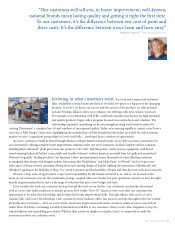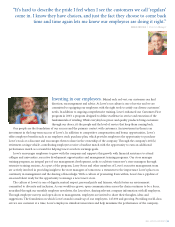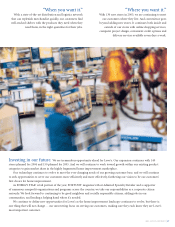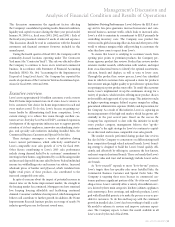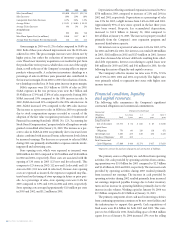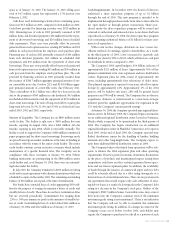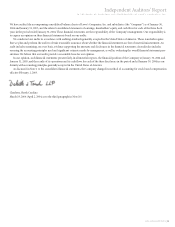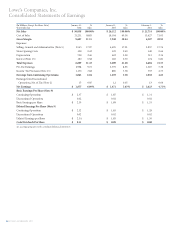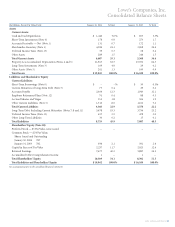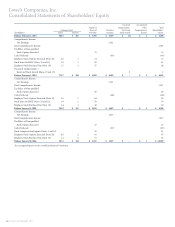Lowe's 2003 Annual Report Download - page 23
Download and view the complete annual report
Please find page 23 of the 2003 Lowe's annual report below. You can navigate through the pages in the report by either clicking on the pages listed below, or by using the keyword search tool below to find specific information within the annual report.
2003 ANNUAL REPORT 21
conditions. However, changes in consumer purchasing patterns
could result in the need for additional reserves. The Company also
records an inventory reserve for the estimated shrinkage between
physical inventories. This reserve is based primarily on actual
shrinkage results from previous physical inventories. Changes
in actual shrinkage results from completed physical inventories
could result in revisions to previously estimated shrinkage
expense. Management believes it has sufficient current and histor-
ical knowledge to record reasonable estimates for both of these
inventory reserves.
Vendor Funds The Company receives funds from vendors in the
normal course of business for a variety of reasons, including pur-
chase-volume-related rebates, defective merchandise allowances,
advertising allowances, reimbursement for selling expenses, dis-
plays and third-party, in-store service-related costs. Management
uses projected purchase volumes to determine earnings rates, vali-
dates those projections based on actual and historical purchase
trends and applies those rates to actual purchase volumes to deter-
mine the amount of funds earned by the Company and receivable
from the vendor. Amounts earned could be impacted if actual
purchase volumes differ from projected purchase volumes. The
Company has historically treated volume-related discounts or
rebates as a reduction of inventory cost and reimbursements of
operating expenses received from vendors as a reduction of those
specific expenses. The Company’s historical accounting treatment
for these vendor-provided funds is consistent with Emerging
Issues Task Force (EITF) 02-16 “Accounting by a Customer
(Including a Reseller) for Certain Consideration Received From a
Vendor” with the exception of certain cooperative advertising
allowances and in-store services provided by third parties for
which the costs are ultimately funded by vendors. The Company
previously treated the cooperative advertising allowances and in-
store service funds as a reduction of the related expense. Under
EITF 02-16, cooperative advertising allowances and in-store serv-
ice funds should be treated as a reduction of inventory cost, unless
they represent a reimbursement of specific, incremental and iden-
tifiable costs incurred by the customer to sell the vendor’s product.
The cooperative advertising and in-store service funds that the
Company receives do not meet the specific, incremental and iden-
tifiable criteria in EITF 02-16. Therefore, for cooperative advertis-
ing and third-party, in-store service fund agreements entered into
after December 31, 2002, which was the effective date of the relat-
ed provision of EITF 02-16, the Company is treating these funds as
a reduction in the cost of inventory and recognizing these funds as
a reduction of cost of sales when the inventory is sold. There is no
impact to the timing of when the funds are received from vendors
or the associated cash flows, but there is an impact to the timing of
income recognition. This accounting change did not have a mate-
rial impact on the fiscal 2003 financial results, since substantially all
of the cooperative advertising allowance and in-store service fund
agreements for fiscal 2003 were entered into prior to December 31,
2002. The Company estimates that this one-time change in
accounting will reduce fiscal 2004 earnings per share by approxi-
mately $0.13 per share.
Self-Insurance The Company is self-insured for certain losses
relating to worker’s compensation, automobile, general and prod-
uct liability claims. Self-insurance claims filed and claims incurred
but not reported are accrued based upon management’s estimates
of the discounted aggregate liability for uninsured claims incurred
using actuarial assumptions followed in the insurance industry
and historical experience. These estimates are subject to changes in
forecasted payroll, sales and vehicle units, as well as the frequency
and severity of claims. Although management believes it has the
ability to adequately record estimated losses related to claims, it is
possible that actual results could differ from recorded self-insur-
ance liabilities.
Operations.
Net earnings for 2003 increased 28% to $1.9 billion or 6.1% of
sales compared to $1.5 billion or 5.6% of sales for 2002. Net earn-
ings for 2002 increased 44% to $1.5 billion or 5.6% of sales com-
pared to $1.0 billion or 4.7% of sales for 2001. Diluted earnings per
share were $2.34 for 2003 compared to $1.85 for 2002 and $1.30
for 2001. Return on beginning assets, defined as net earnings divid-
ed by beginning total assets, was 11.7% for 2003, compared to
10.7% for 2002 and 9.0% for 2001, and return on beginning share-
holders’ equity, defined as net earnings divided by beginning
shareholders’ equity, was 22.6% for 2003, compared to 22.0% for
2002 and 18.6% for 2001. Return on invested capital, defined as net
earnings plus after-tax interest divided by the sum of beginning
debt and equity, was 16.5% for 2003, compared to 15.1% for 2002
and 13.8% for 2001.
Sales amounts are from continuing operations and exclude
sales from the Contractor Yard locations. The Company recorded
sales of $30.8 billion in 2003, an 18% increase over 2002 sales of
$26.1 billion. Sales for 2002 were 20% higher than 2001 levels. The
increases in sales are attributable to the Company’s ongoing store
expansion and relocation program and comparable store sales
increases. Comparable store sales increased 6.7% in 2003, com-
pared to 5.8% in 2002. Average ticket increased 4% from $56.80 in
2002 to $59.21 in 2003 due in part to the success of the up-the-
continuum initiative as well as Lowe’s credit programs.
The comparable store sales increase in 2003 primarily resulted
from improved sales in every merchandising category due to the
initiatives previously described. During the year, the Company
experienced its strongest sales increases in lumber, building mate-
rials, outdoor power equipment, paint, flooring and home organi-
zation. Major appliances continue to perform well and also exceed-
ed the Company average comparable store sales increase. In addi-
tion, millwork, hardware, walls & windows, nursery and cabinets
performed at approximately the overall corporate average compa-
rable store sales increase. Comparable store sales were positive for
every product category and all geographic regions due in part to
the implementation of the merchandising and operations strate-
gies previously discussed. The Company experienced slight infla-
tion in lumber and building material prices during the year, which
positively impacted comparable store sales by 50 basis points. The
following table presents sales and store information excluding dis-
continued operations:


